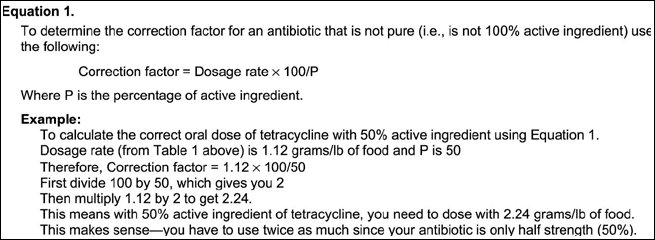 |
 |
Percent Active Ingredient
Many antibiotics commonly used for ornamental fish are sold by different companies; therefore, the percent of active ingredient will vary from product to product. This means that you may not have 100% of pure antibiotic required for disease control. You need to ask your supplier to provide you with the actual percentage of antibiotic that is active in the product you have purchased and calculate your dosage accordingly. For example, if your product contains less that 100% of active ingredient, your dosage needs to be increased to bring the level up to the equivalent 100% active ingredient. (See Equation 1.) If you are still unsure how to do this calculation, call your local fish health specialist.
Equation 1

Major Routes of Administration
- Injection: Injection is the most direct and effective method for getting antibiotics into the blood stream. Unfortunately, this process is very labor intensive and impractical for fish grown on a commercial scale. However, for small numbers of fish, or for important or expensive fish, injection may be the best method.
- Mixed in food: In aquaculture production, the most cost effective and commonly used method to deliver antibiotics, is orally by mixing them into food. The proper dose of antibiotic is mixed into the feed using fish oil or canola oil as a binding agent, and the mixture is then fed to the fish for the prescribed number of days. Oral administration of antibiotics requires that most of the fish are still eating, so every attempt should be made to catch bacterial diseases early, before the majority of fish stop eating. It is a good idea to train fish to eat a prepared diet (i.e., one that can be used to incorporate antibiotics), so that, should it becomes necessary to use antibiotics, the fish will be more likely to eat the medicated food as it is familiar to them.
- Bath treatments: Although bath treatments are a popular method of administering antibiotics, much more drug is required when compared with oral treatments or injections to achieve the desired result. In many cases, even a large amount of antibiotic in the water does not guarantee that enough of it will get into the fish to be an effective treatment. At the same time, excessive amounts of antibiotic in the water can increase the likelihood of water-borne bacteria developing resistance to that drug. Furthermore, to avoid poor water quality and any potential toxicity, between 70% and 100% of the water should be changed at the end of each daily treatment and also prior to redosing. Finally, bath treatments are not recommended in recirculating systems or in any aquarium system where the treated water will contact the biological filter, because the antibiotics will kill or inhibit the nitrifying bacteria in the biological filters (see UF/IFAS Fact Sheet FA-16 Ammonia). If treating fish in a bath, ideally a separate container should be used, or tanks and vats should be taken off-line during treatment. In summary, bath treatments should be considered only when the majority of the fish are not eating, or when treating primarily external bacterial infections and fish should be switched to oral medications as soon as they resume eating.
more ...
|
 |





